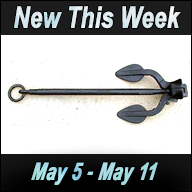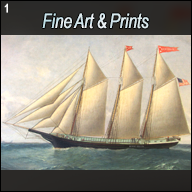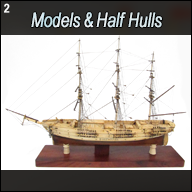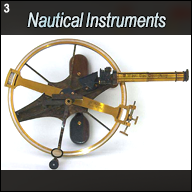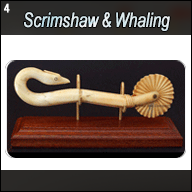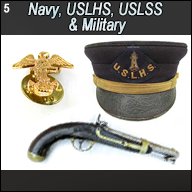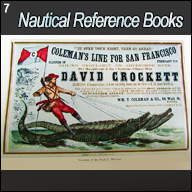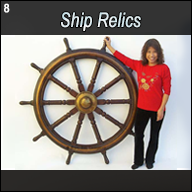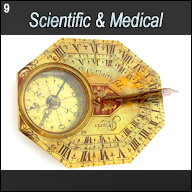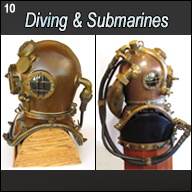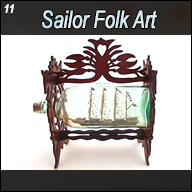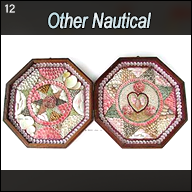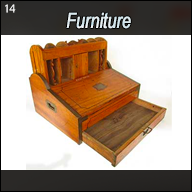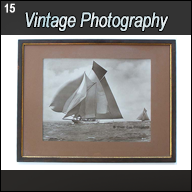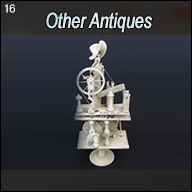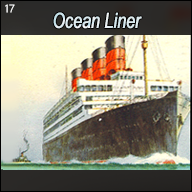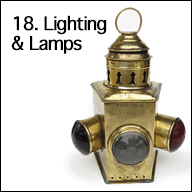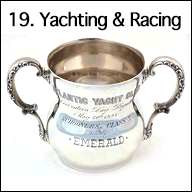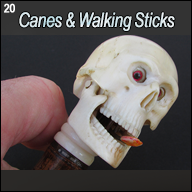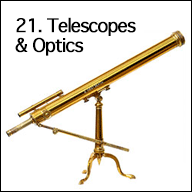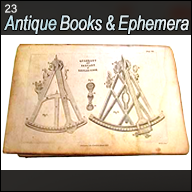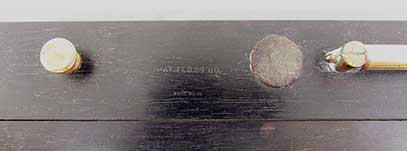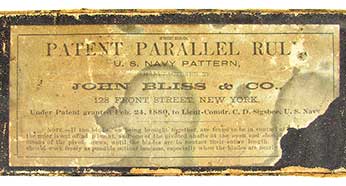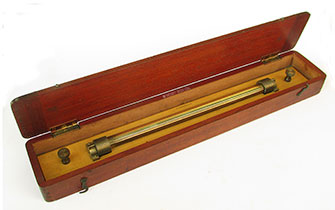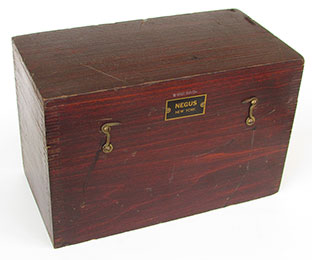3. Nautical Instruments
Prices in U.S. Dollars are in GREEN
 |
3.46 EARLY PARALLEL RULES. An especially sweet example of a ship’s navigator’s chart rules form the early 1800’s. This delightfully petite instrument is made of rare (now virtually extinct) British boxwood with brass fittings. Known as a “rolling rule” the ingenious design incorporated 2 serrated rollers on a central column to traverse the chart table without changing the rule’s longitudinal orientation. As such the proposed ship’s course could be set over a variety of options on the chart table. This high quality instrument is likely of English manufacture. It measures 12 inches long 1 7/8 inches wide. It is in literally magnificent original condition with a rare. Very sought after “tiger stripe” grain pattern. Truly one of the nicest of its genre we have encountered in our 40+ years. A keeper! 195 |
 |
 |
| detail | bottom |
 |
3.43 VERY EARLY COMPASS BY THE INVENT0R. Dated, post-Civil War American ship’s compass by the inventor and manufacturer of the first reliable LIQUID compass as signed on the brass rim “E.S. Ritchie, Boston.” It is further signed inside on the cross float “RITCHIE BOSTON” in the maker’s own hand. This unique configuration, sometimes referred to as a “doughnut compass,” was not the typical flat disc, but rather an inward facing rim supported on 2 tubes. It is marked in one half points of the compass with the cardinal and intercardinal points identified. North is designated by a classic fleur-de-lis. The compass rim bears 5 U.S. patents dates, the first being Sept. 9, 1862 and the last Aug. 17, 1875. A very unusual feature of this liquid-filled compass is that the brass bezel is knurled to literally screw onto the compass body rather than being secured by screws as in most all other compasses. The body has 2 prongs for suspension of a gimbal ring. 5 ½ inches wide from tip to tip. The compass rim is 5 inches in diameter. Excellent original condition exhibiting 150 years of careful use. Remarkably, the compass still contains its original fluid and readily points to magnetic north. 395 Edward Samuel Ritchie was born in 1814. In 1839 he established a hardware business in Boston, Massachusetts with a partner forming the firm of Palmer & Ritchie. From 1842-1849 he operated a ship’s chandlery in New Bedford. In1850 Ritchie began his scientific instrument making career with Nathan Chamberlain as a partner. By 1862 the company was known as Edward S. Ritchie & Co. Then in 1867 the firm name became E.S. Ritchie & Sons.Ritchie is credited with inventing the first practical liquid-filled compass circa 1860. In 1861 he produced a compass for the famed Civil War iron clad USS MONITOR and was awarded his first patent for the invention on September 9, 1862, at the height of the war. A number of improvements and subsequent patents followed. The elder Ritchie died in 1895, but his sons carried on the business, which still survives today as E. S. Ritchie & Sons, Inc. Pembroke, Massachusetts. |
 |
 |
| perspective | number |
 |
| maker |
 |
3.41 PARALLEL RULES. Delightful set of miniature parallel rulers used by the navigator of a WWI British warship. This diminutive pair is made with limbs of ebony and brass fittings. It is stamped by the famous makers “H. HUGHES & SON, LTD LONDON 1915” on one limb. Adding to its rarity and value is the fact that both brass arms bear the British broad arrow mark indicating it was used in the British Royal Navy. 6 inches long by 1 5/8 inches wide closed. Very early World War I. Perfect original condition. Sweet! 149 (See item 3.37) |
 |
 |
| open | maker |
 |
3.40 EARLY BRASS SEXTANT. Mid-1800’s century mariner’s sextant by the noted English makers “Keen & Frodsham, Liverpool” as beautifully engraved in script on the large arc. This all brass instrument has inlaid scales of silver. The large arc is calibrated in single degrees from -5 to 125 subdivided by 20 arc minutes, marked by 10’s. The silver vernier scale inlaid into the index arm is calibrated in arc minutes from 0 right to 15 left, subdivided by 15 arc seconds, in theory at least, providing an accuracy of 1/3 nautical mile. The reading is aided by a built-in pivoting magnifier on the braced brass index arm. The instrument is complete with both index and horizon mirrors as well as all 4 index sun filters and 3 horizon filters. All are in excellent original condition. A threaded sight holder is provided to support a telescopic sight and peep tube, both of which are retained in the box. The back of the sextant has a sculpted ebony wood handle and three “feet” for positioning in its box. The handsome keystone box is made from rich mahogany with two hook and eye closures and the original box lock. As noted, both sight tubes are present along with the mirror box adjusting wrench and a screw-on eyepiece filter. The instrument itself measures 9 ½ inches high by 8 ½ inches wide. The box measures 11 inches tall by 11 inches wide and is 5 inches thick. Overall condition is excellent in all respects, noting expected wear from careful use over more than 160 years! Easily a $1500 value. 975 The venerable instrument making partnership of Keen and Frodsham was formed between Robert John Keen (w. 1834-1857) and Henry Frodsham (w. 1835-1856) to produce high quality navigational instruments in the mid-1800’s. (Gloria Clifton, “Dictionary of British Scientific Instrument Makers 1550-1851,” 1995, The National Maritime Museum Greenwich, and Phillip Wilson Publishers, London). In October 1856 Henry Frodsham joined a nautical instrument maker by the name of Robert John Keen of 18 Salthouse Dock, Liverpool in partnership at 17 South Castle Street. By 1857 their address was 11 New Wapping, Liverpool under the name Keen & Frodsham Chronometer Makers and Opticians. In addition to clocks, watches and chronometers, the partnership sold barometers, telescopes, sextants, quadrants, hour glasses, microscopes, binnacles, compasses, log books, etc. (p. 57. Vaudrey Mercer, “The Frodshams The Story of a Family of Chronometer Makers,” 1981, The Antiquarian Horological Society, Church Hill, Ramsgate, Kent). |
 |
 |
| box | in box |
 |
 |
| detail | instrument |
 |
 |
| maker | signature |
 |
3.39 CASED OCTANT. Very clean and complete mid-1800’s octant with the ivory maker’s plate signed “SPENCER, BARRETT & Co. LONDON.” This fine navigational instrument has limbs of ebony with brass furniture and ivory scales. The large ivory arc is calibrated in degrees from -3 to 108 sub-divided by 20 arc minutes, marked by 5’s. The ivory vernier is calibrated from right to left 0 - 20 indicating an accuracy of a single arc minute. The braced brass index arm is 13 inches long, operated by a knurled brass locking screw on the reverse and a knurled tangential fine adjustment screw. It has the typical mirror box adjustment apparatus on the reverse and 3 brass “feet” for mounting in the box. The frame is complete with its index and horizon mirrors, its full set of index filters and it singular round horizon filter. The horizon mirror contains a rarely found adjustment feature. The non-telescopic peep sight is reminiscent of quadrants from the 1770’s with its pivoting shade over the 2 sights. All brass components are in a remarkable state of bright brass, original preservation. The box too exhibits 18th century form being of the “stepped keystone” variety made of oak. It is complete with its original skeleton lock and striker plate. This fine instrument measures 13 inches tall by 10 ½ inches wide. The original box is 14 inches long by 12 ½ inches wide and 4 inches thick on the upper tier. Considering it age, this instrument is in outstanding original condition in all respects. Far above average. Absolutely no noticeable flaws. Priced to sell!!! 695 Spencer & Co., London began business in 1817. They were known to have sold octants. In the early 2000’s this instrument would have easily sold for $1995. Figure that with inflation! |
 |
 |
| detail | instrument |
 |
 |
| back | vernier |
 |
 |
| maker | box |
 |
3.37 NAVIGATOR’s RULES. Very early 1800’s parallel rules of the type used by the ship’s navigator to determine courses and positions of his ship on the vessel’s charts. This fine old example is made with limbs of solid ebony affixed with 2 pivoting brass arms. For aid in positioning brass “buttons” are provided on the center of each arm. Each arm is squared on the leading edge and beautifully chamfered on the trailing edge. The brass has acquired a lovely bronze age patina and the ebony wood is solid and straight, without flaw. 15 inches long by 2 3/8ths inches wide. Excellent, fully functional condition showing years of actual use at sea. 95 (See item 3.34). |
 |
 |
| open | back |
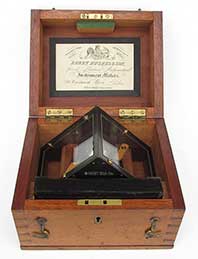 |
 |
 |
| box | perspctive |
 |
 |
| label | contents |
 |
 |
| interior | components |
 |
3.34 18th C. NAVIGATOR’s RULES. Especially nice parallel rolling rules made by the preeminent English makers “W. & S. JONES * 30 HOLBORN LONDON” as marked in the center. This early navigational instrument is made of ebony and ivory with brass fittings. It consists of an internally weighted rolling axle with corrugated brass drums on each end. The drums grasp the surface of the chart allowing the instrument to travel in a parallel direction. Of special note are the ivory ends of the roller which trace from 0 to 2 inches in increments of 1/10th inch when rolled. This complication is in addition to the fact that the leading edges are ivory scales marked in tenths of inches from 0 to 12! Absolutely pristine original condition in all respects. It is hard to believe this original instrument is more than 220 years old! 349 William and Samuel Jones began their scientific instrument manufactory on Holborn Hill, London in1791. (Gloria Clifton, “Directory of British Scientific Instrument Makers 1550-1851, 1995, National Maritime Museum and Philip Wilson Publishers, Ltd.) |
 |
 |
| detail | bottom |
 |
 |
| maker | roller |
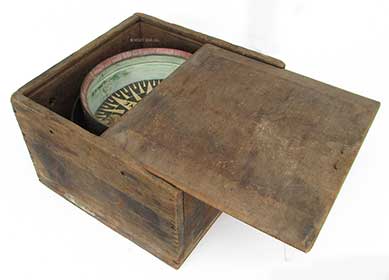 |
 |
 |
| box | in box |
 |
 |
| bowl | card |
 |
| north point |
3.31 INCLINOMETER. Very finest quality turn-of-the-last-century English steamship’s pilot house clinometer with white enameled dial signed “<HEZZANITH>.” This precision navigational instrument is marked in single degrees of the ship’s heel (roll) from 0 to 50 port and starboard, marked by 10’s. A knurled thumbscrew at the bottom locks the pivoting indicator need in place when the instrument is not in use. The heavy solid brass case is mounted to a lovely laminated backboard having 3 brass brackets. Attaching only the top bracket allows the instrument to rotate and the needle to move. If all 3 brackets are attached it will register as designed on a rolling ship. The brass case is 8 ¾ inches in diameter on the flange. With brackets the entire assembly measures 12 inches across and weighs a hefty 9 pounds. WAS $795 NOW! 295 |
 |
| perspective |
 |
3.28 PRISTINE BOXED COMPASS. Turn-of-the-last-century American small craft boxed compass by the famous maker “E. M. Sherman, Seattle, DIRIGO Trade mark,” as signed on the composition compass card. This liquid-filled compass has a rose marked in points of the compass down to ½ points and is also marked in 10’s of degrees on the periphery. North is denoted by a fancy fleur-de-lis. The center has a high quality agate pivot. The detailed card is a mere 2 inches in diameter while the bronze compass body is 3 inches across. It is set in its stout bronze gimbal ring. The entire unit is mounted in its machine dove-tailed oak box with lid. Two brass hooks and 3 dowelled “keepers” assure the box closes securely. 4 ¾ inches square by 3 ¼ inches high. Unbelievably, this item is over 100 years old! They don’t come any nicer. 389 The well-known Dirigo compass was first manufactured in Lexington, Massachusetts by boat builder and violin maker Eugene M. Sherman in 1907. Sherman was born in Somerville, Massachusetts to a New England seafaring family in 1872. “Dirigo,” translated from Latin means “I Lead.” In 1911, Sherman moved to the Pacific Northwest where he opened his compass making business in Bellevue, Washington. This compass dates to his early manufactory. He sold his stake in the company in 1944. |
 |
 |
| box | in box |
 |
 |
| detal | card |
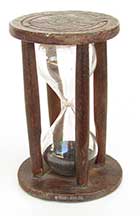 |
3.26 LOG TIMER. Authentic mid-19th century ship’s timer used in conjunction with a chip log to determine a ship’s speed and position using dead reckoning. Of significance, this navigational instrument was commercially-made. It consists of a hand blown glass vial with two bulbous section connected by a narrow neck in the middle. One of the bulbs contains a cloth plug by which iron filings were inserted. The glass is contained within two turned wooden discs supported by 4 simple wood columns. The discs are decoratively scribed with concentric circles and the end with the plug bears a paper label. The embossed lettering reads “28 SECONDS.” It is difficult to read but is legible under magnification. The timer measures 2 7/8 inches in diameter and stands 4 ½ inches tall. It is in working condition and surprisingly accurate. 679 The exact origins of sand timers are unclear, although they are generally attributed to the Arab world. From ancient times the passage of water was used as a measurement of time in "water clocks." As a follow-on, the "fluid dynamics" of flowing sand was seen to be similar. "By the Middle Ages the sand-glass came into its own, fragile though it was, this was the first clock which the men who made the great voyages of discovery took with them." (Jean Randier, "Nautical Antiques for the Collector, 1977, Doubleday & Co., New York, page 96). "Dating old sand glasses can be difficult, but the color or tint of the bulbs is a help. The glass was greenish up to about 1700. During the 18th century it was darker; then in the 19th century it gradually acquired the transparency of crystal. There were also variations in the actual sand which, prior to about 1720, was reddish or orange-red in color. After about 1720, white or green sand was increasingly used." (Alan Major, "Marine Antiques," 1981, A.S. Barnes & Co., New York, pages 178-179.) Mariners have used the chip log for dead reckoning navigation since the first known description of the device in print. That was "A Regiment for the Sea" by William Bourne in 1574. Bourne devised a half-minute sand glass for timing. At that time, a mile was the equivalent of 5,000 feet. At a speed of one mile per hour a ship would travel about 42 feet in 30 seconds: Distance in feet = 1 mile/hour (3600 seconds) = 30 seconds x 5000 feet / 3600 seconds = 42 feet In early times the length of the log-line was measured directly by sailors as it passed through their hands. With the introduction of the nautical mile as a standard unit of measure at sea in the 15th century, they began to mark the line at equal intervals proportional to the nautical mile and to the time interval used for measurement. At first the markings were simply knots in the line. Later, sailors worked identifying knotted cords into the log-line. Most ships used knots spaced 7 fathoms (42 feet) apart. The time interval was therefore directly related to distance between knots in the line. Using 6,000 feet (or 2,000 yards) for 1 nautical mile, the above formula yields 28 seconds for a distance of 7 fathoms. With the advent of steam propulsion and faster ships in the first half of the 1800’s, the duration of the sand timer was cut to 14 seconds. |
 |
 |
| running | label |
 |
3.25 SEXTANT PAMPLET. How to use a sextant, entitled “How to Find Your Position With The Master Sextant.” This instructive paperback booklet contains 15 pages crammed with information on how to take a sighting with a sextant and then use that information to compute the longitude. There are also sections on how to use the sextant as a pelorus and as a heliograph. Well illustrated with charts and line drawings. Published by Davis Instruments, San Leandro, CA. Condition of the cover is fair. Content is fine. Shipped First Class mail at no additional cost. 16 |
 |
| plate |
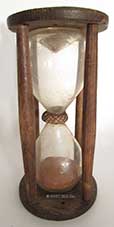 |
3.21 VERY EARLY LOG TIMER. Quite exceptional mid-1700’s or earlier ship’s log timer of 28 seconds used in the dead reckoning method of navigation to determine a ship’s speed. This amazing survivor from the early days of sail is of classic form with 2 hand-blown greenish glass vials conjoined in the middle with wrapped leather and twine. The frame consists of two oak discs connected by 4 turned pine columns which hold the discs together while protecting the vials. Both ends of the timer discs exhibit concentric circle decorations. The timer measures 6 inches tall and 3 1/8 inches in diameter. It is in excellent original condition considering its 250+ year old age! The sand runs strong and is nearly accurate. A true museum piece if ever there was one! The exact origins of sand timers are unclear, although they are generally attributed to the Arab world. From ancient times the passage of water was used as a measurement of time in "water clocks." As a follow-on, the "fluid dynamics" of flowing sand was seen to be similar. "By the Middle Ages the sand-glass came into its own, fragile though it was, this was the first clock which the men who made the great voyages of discovery took with them." (Jean Randier, "Nautical Antiques for the Collector, 1977, Doubleday & Co., New York, page 96). "Dating old sand glasses can be difficult, but the color or tint of the bulbs is a help. The glass was greenish up to about 1700. During the 18th century it was darker; then in the 19th century it gradually acquired the transparency of crystal. There were also variations in the actual sand which, prior to about 1720, was reddish or orange-red in color. After about 1720, white or green sand was increasingly used." (Alan Major, "Marine Antiques," 1981, A.S. Barnes & Co., New York, pages 178-179.) Mariners have used the chip log for dead reckoning navigation since the first known description of the device in print. That was "A Regiment for the Sea" by William Bourne in 1574. Bourne devised a half-minute sand glass for timing. At that time, a mile was the equivalent of 5,000 feet. At a speed of one mile per hour a ship would travel about 42 feet in 30 seconds: Distance in feet = 1 mile/hour (3600 seconds) = 30 seconds x 5000 feet / 3600 seconds = 42 feet In early times the length of the log-line was measured directly by sailors as it passed through their hands. With the introduction of the nautical mile as a standard unit of measure at sea in the 15th century, they began to mark the line at equal intervals proportional to the nautical mile and to the time interval used for measurement. At first the markings were simply knots in the line. Later, sailors worked identifying knotted cords into the log-line. Most ships used knots spaced 7 fathoms (42 feet) apart. The time interval was therefore directly related to distance between knots in the line. Using 6,000 feet (or 2,000 yards) for 1 nautical mile, the above formula yields 28 seconds for a distance of 7 fathoms. With the advent of steam propulsion and faster ships in the first half of the 1800’s, the duration of the sand timer was cut to 14 seconds. |
 |
 |
| perspective | running |
 |
3.22 TINY AMERICAN BINNACLE. Absolutely charming, near miniature compass binnacle. This diminutive device is made of rich mahogany with dove tailed joints and brass hardware. For viewing it has a glazed “trap door” in front, hinged at the top and splined for durability. The old wavy glass is held in place with putty in the traditional manner. The window measures 2 ½ by 3 ¾ inches. Inside, the all brass compass is dry, suspended in its original brass gimbal ring. The compass card is marked down to ¼ points of the compass rose with the Cardinal and Intercardinal points identified. It is further marked in single degrees on the periphery, identified by 10’s. Speaking to its quality it has a jeweled center pivot and 4 bar magnets for accuracy. The card measures 3 inches in diameter; the compass bowl 4 ¼ inches across. The top of the binnacle has a folding brass handle for carrying and retains hook and eye closures on both sides to secure the door. The inside rear of the binnacle retains the original old maker’s label reading ‘WILCOX CRITTENDON & Co., Inc., Middletown, Conn., U.S.A.” stamped with an illegible date “FEB 14…” What is truly remarkable about this little binnacle is that it is complete with its darling oil-fired binnacle lamp for night viewing. The lamp has its original whale oil burner which screws into the bottom with a bayonet twist. The glazed lens fits into a brass aperture on the back of the binnacle opening above the compass. A spring-loaded clip with a “keeper” insures a secure fit. The existence of a detachable side lamp on such a small binnacle is extremely rare. This fact more than doubles its value and appeal! The binnacle measures a mere 6 inches wide by 7 inches tall exclusive of the handle and 9 inches deep inclusive of the lamp. Outstanding original condition in all respects. The compass is lively and accurate, gimbaling freely within its housing. SOLD |
 |
 |
| interior | side |
 |
 |
| lamp | lamp reverse |
 |
| lamp open |
 |
3.16 EXCEPTIONAL NOCTURNAL. Splendid, incredibly rare and eagerly sought after by advanced collectors, instrument used by early mariners for telling time at night, hence the name “nocturnal.” This 17th century English example is made of rich golden brown boxwood with square and hexagonal brass “nuts” framing the sighting hole. It measures 10 ¾ inches overall including the index arm. The dial is 4 5/8 inches in diameter. It is complete with the rotating volvelle and a rotating pointer arm for alignment with the stars of the big and little dippers ( Ursa Major and Ursa Minor) the greater and lesser bears, labeled “GB” and “LB” respectively. The instrument is divided and stamped with scales for the date, hour, lunar age, and polar distance, with a detailed compass rose on the reverse. The handle has a lovely pierced heart design and is stamped on the front side “BOTH BEARS.” Condition is absolutely phenomenal. It is the best wooden nocturnal we have ever seen in or out of public holdings. 6889 In use the volvelle is set to the correct date with the selected constellation. Holding the nocturnal is held vertically, the Pole star is sighted through the central hole. The long arm is then aligned with the stars of the dipper. So-aligned, the local time is indicated on the central scale The scale on the reverse also gives the correction for Pole Star elevation in order to compute the latitude. The lunar age scale permits determination of high and low tides. As such, it was a simple but very effective early multi-function navigational tool. Because of its simple wooden construction very few examples survive. See “TESSERACT” catalog of early scientific instruments Summer of 1999, Number 64, item 18. It depicts a similar, smaller nocturnal with some condition issues, which sold for $8,750. Adjusted for in inflation it was $15,845 in today’s dollars. A further consideration is that this nocturnal is now even a quarter of a century older! |
 |
 |
| front detail | back |
 |
| back detail |
 |
 |
 |
| box | closed |
 |
 |
| card | eagle |
 |
 |
| engraver | inner bowl |
 |
3.13 18th CENTURY COMPASS. Museum worthy mid-1700’s or earlier English-made travelling compass of the finest quality. This handsome instrument features the classic compass rose found on such early instruments. The card is hand-engraved paper set on a mica backing supported on a brass pivot with clear agate bearing. The card is marked in 32 points of the compass with the Cardinal and Intercardinal points identified. North is denoted by a fancy fleur-de-lis and East bears the traditional archaic decoration. The circumference of the card is marked in single degrees identified by 10’s. The center of the card around the pivot is decorated with a subtle octagon design. The card is housed in its cylindrical brass case with scalloped bezel containing old wavy glass. Of special note is the fact that the original press-on cover with knurled rim is still present after 250+ years! 3 ¼ inches in diameter and 1 3/16 inches thick. Virtually pristine original condition showing expected age patina. WAS 895 NOW! 495 The earliest usage of the compass in the Western world took place during the Crusades from Europe to the Holy Land in the 11th century A.D. It was during these Crusades east that the Christian cross became symbolic of the "East" point on the compass rose. The tradition of the "decorated East" point remained with mariners until the late 18th century. |
 |
 |
| card | case |
 |
3.15 EARLY AMERICAN OCTANT BY IMPORTANT MAKERS. A fine Captain’s navigational instrument made by America’s foremost 19th century instrument makers “E. & G. W. Blunt, New York” as hand-engraved on the large arc. This especially beautiful all brass instrument bears a large inlaid silver arc calibrated in single degrees from -4 to 115, sub-divided by 20 arc minutes, marked in 10’s. The silver vernier scale on the index arm is calibrated from 0 to 20 arc minutes subdivided by 30 arc seconds, giving a theoretical accuracy of about ½ nautical mile at the equator. The index arm is provided with a pivoting magnifier for a precise reading. The cast solid brass frame supports the sight tube holder, index mirror, 4 index filters, horizon mirror and 3 horizon filters, all of which are without damage, complete and functional. The reverse of the instrument retains its lovely sculpted rosewood handle, mirror adjustment apparatus and 2 brass “feet.” It is fitted into its original keystone mahogany box bearing the partial label of the equally revered nautical instrument makers “THAXTER & SON, Boston.” This early style box is in remarkably well preserved condition, with none of the typical cracks, and is complete with both optics, 2 sun filters and adjusting wrench. The instrument measures 9 ¾ inches long on the index arm and 8 ½ inches wide on the large arc. The fitted box measures 11 inches tall by 11 inches wide. Seeing is believing. For the well versed collector, they really don’t come any nicer than this! SOLD The fact that the large arc is calibrated up to 115 degrees designates this instrument as an “octant” rather than a sextant, which would exhibit a scale of 130 degrees or more. |
 |
 |
| box | interior |
 |
 |
| instrument | back |
 |
 |
| vernier | signature |
 |
| label |
 |
3.10 EARLY SEXTANT. Particularly well preserved 19th century English sextant made by the noted scientific instrument makers “Negretti & Zambra, London” as finely engraved in script on the large arc. This classic 3-circle sextant has an inlaid silver scale reading from -5 to 160 degrees, effectively making it a “quintant.” The scale is marked in 10’s of degrees and each degree is subdivided to 10 arc minutes. The silver vernier scale at the bottom of the index arm reads from 0 to 10 arc minutes right to left, subdivided in 10 arc second increments, theoretically allowing for an accuracy of 30 nautical miles. In use the index arm has a knurled thumbscrew stop and a fine adjust tangent stop. A pivoting magnifier and a frosted glass light diffuser are mounted on the index arm for viewing the reading. This all brass instrument is complete with both mirror boxes, height adjustable telescope holder, all 4 index filters and complete set of 3 horizon filters. It retains its original blackened finish throughout. The back has its original 3 “feet” for mounting in its box and its lovely sculpted solid rosewood handle. The index arm measures 8 ¼ inches long and the large arc is 9 inches wide making for a very diminutive instrument. The handsome solid mahogany box is of hand-dovetailed construction with brass furniture. It contains one long telescope with 2 interchangeable eye pieces, a separate peep site and screw-on sun filer. The box has two hook and eye closures, the original skeleton lock with escutcheon and folding brass drop handle. It is in remarkable condition with no major cracks in the large single panel lid. It measures 9 ¼ by 9 ½ inches by 4 ¾ inches thick. Fabulous cosmetic condition. 1285 For someone considering a single quality instrument of this type to fill out a nautical collection, this is it! The partnership of Enrico Negretti and Joseph Warren Zambra began at 11 Hatton Garden, London in 1850. Exhibiting at the Great Exhibition at the Crystal Palace London in 1851, they won a Prize Medal. Thereafter the business expanded rapidly and they were awarded the Royal appointment of instrument makers to the Queen and the Prince Consort. The firm was the most prolific manufacturer of scientific instruments in the second half of the 19th century in England. The partnership made all manner of quality scientific instruments, best noted for their barometers and telescopes. (Edwin Banfield, "Barometer Makers and Retailers 1660-1900," 1991, Baros Books, Wiltshire).
|
 |
 |
| box | in box |
 |
 |
| sextant | back |
 |
| signature |
 |
3.14/5.46 U.S. NAVY CLINOMETER. Authentic World War II fighting ship's pilot house inclinometer made for the Navy by the John L. Chaney Instrument Company. The face of the Bakelite body is engraved: CLINOMETER
U.S. NAVY BU-SHIPS MK IV 1943 JOHN L. CHANEY INSTR. CO. LAKE GENEVA WISC., U.S.A. This precision device is calibrated in single degrees of heel port and starboard up to 70 marked by 10's. The reading is made by a small black ball within a curved glass tube containing fluid. The fluid acts to dampen (slow) the ball as the ship rolls. This is exactly the same principle used in an aircraft's turn and bank indicator. The instrument measures 12 ½ inches wide by 6 ¼ inches high. It is in excellent original condition. The action of the ball is perfect. 395 |
 |
| back |
 |
3.11 BOXED COMPASS. Late 19th century American small craft boxed compass made by the “Coston Supply Co., New York” as stenciled on the bottom of the bowl. The composition card is marked in ½ points of the compass with the cardinal and intercardinal points identified. North is denoted by a classic fleur-de-lis and “Polaris.” It is mounted on a high quality jeweled pivot. This all brass compass retains its handsome original black e-enameled surface. The compass is slung in gimbals, mounted in the original mahogany box with lid, held by 2 pivoting hooks. The compass measures exactly 3 inches in diameter and the box is 4 ½ inches square by 3 ¼ inches high with lid. Excellent original condition throughout showing signs of use but no abuse. 329 The Coston Company was established in 1840 by Benjamin Franklin Coston, inventor and manufacturer of night signals and ship rockets. He continued as head of the business until his death in 1901, when the business was incorporated. In the early 1900’s the company expanded its product line to include life-saving appliances for ships as well as general steamship supplies. But it was always best known as an innovator and leader in ships’ distress signaling devices. |
 |
 |
| compass | box |
 |
3.06 BINNACLE INCLINOMETER. Authentic World War I era pilot house binnacle clinometer made by the noted American makers Kelvin and Wilfred O. White as boldly marked on the silvered brass dial "KELVIN-WHITE CO. BOSTON & NEW YORK." This precision nautical instrument features a blackened brass pendulum bob overriding an arched scale reading in 2 degree increments from 0 to 40 degrees port and starboard. It is housed in its solid brass case under glass. The back is curved to fit the front of the binnacle and there are mounting tabs on each side to accommodate screws. Functional original condition with a lovely age patina to the brass surfaces. The silver dial is perfect. 179 |
 |
 |
inclined |
back |

|
3.04 NAVIGATOR's PROTRACTOR. Patented 19th century American navigational device which consists of a T-square mounted on a long brass arm over which a brass circle with compass rose is mounted. The circular rose is divided to ¼ points of the compass with the cardinal and intercardinal points identified. North is designated by a classic flue-de-lis. The rose is mounted in such a way that it slides the full length of the supporting arm while being able to rotate a full 360 degrees. The pivot point is off center allowing for cross hairs to pinpoint the precise point on a chart. This ingenious device is of all brass construction. It is stamped with maker's mark "J. W. STRANGE Manufacturer, BANGOR, ME." It is additionally marked"Pat'd June 13. 1876." The long arm measures 16 inches in length and the cross bar 4 ½ inches. The disc is 4 inches in diameter. Outstanding original condition with nice golden lacquer surfaces, virtually the same as it was when made 140+ years ago! A very rare American navigational relic. 389 |
detail |
back |
disc |
maker |
patent |

|
open |
back |
signature |

|
3.89 PROTRACTOR & RULE. Genuine mid 19th century American ship's navigator's chart rule with directional protractor. This ingenious device was made by "L. MORGAN & SON 650 E. 12. ST. N.Y." as stamped on the silvered brass back plate. It consists of a heavy rosewood rule with silvered brass edges. Inset into the middle is a semicircular protractor marked in segments of the compass rose with north at the top, divided east to west in one quarter points . The protractor rotates to the appropriate course or line of bearing and is locked into placed by the knurled brass knob at the top. Just above the pivot point the protractor is marked "PAT. JAN. 19 69. This high quality precision navigational instrument measures 17 inches long by 2 ¼ inches wide on the rule itself. With the silvered protractor it stands 4 ¼ inches high. This is a very rare American navigational instrument of exceptional quality circa 1870 in beautiful original condition. 669 |
perspective |
protractor |
patent |
maker |

|
in box |
card |
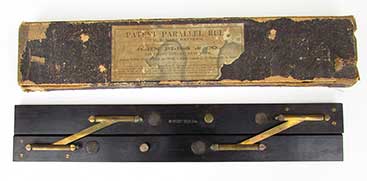
|
3.88/ 5.04 PATENT NAVY PARALLEL RULES. Rare 4th quarter of the 19th century navigator's parallel rulers made by John Bliss and Co., in accordance with LCDR Sigsbee's patent. This beautifully preserved set is made of ebony with brass fittings. It is uniquely constructed in such a manner so as to allow the limbs of the instrument to fold over the chart and align at a distance from the indicated course. This allowed the navigator to "hop scotch" across the chart without sliding the rules over the map's surface. The upper rule is stamped "PAT. FEB.24' 80." Remarkably, it is preserved within its original cardboard box with label reading "PATENT PARALLEL RULE U.S. NAVY PATTERN JOHN BLISS & CO., Under Patent granted Feb. 24 to Liuet-Comdr, C. D. Sigsbee U.S. NAVY." The rules are in absolutely perfect original condition measuring 15 inches long by 2 5/8 inches wide. The original box is 15 ¼ inches long by 3 inches wide and ½ inches thick. As expected the box shows considerable wear after 140 years. But the label with minor losses is still legible. 595 An identical item "Sigsbee's Patent Parallel Rules No. 272" is held in the collection of the Peabody Museum, Salem, Massachusetts. |
positioned |
rules |
patent |
label |

|
in box |
components |
profile |
card |

|
3.79 VERY EARLY AMERICAN BINNACLE. First quarter 1800's boat binnacle by the esteemed American makers Samuel Thaxter and his son as indicated around the pivot point of the drycard compass "S. THAXTER & SON. Boston." This very rare navigational instrument has a heavy solid brass housing. Within is contained the high grade drycard compass marked in points of the compass rose down to ½ points, with the cardinal and intercardinal points identified. Speaking to its quality it has an agate bearing in the brass pivot and the card is backed by mica. Two other significant attributes are its decorated east point, and the fact that the innovative compass bowl is brass and not wood, as used up until about 1820. We were told by the original owners this compass is dated "1818," but we have not opened the body to confirm. The compass bowl and its gimbal are supported within the very substantial binnacle housing with glazed viewing port. The top is fitted with a heavy duty suspension ring for portability. The side bears an auxiliary lamp for night viewing. It contains a small font with whale oil burners – again, a testament to its early origins. The compass measures 5 ½ inches in diameter. The cast brass binnacle base is 9 ½ inches in diameter and the binnacle stands 11 ½ inches tall exclusive of the ring. Totally complete and in excellent original condition in all respects, showing its great age. 1179 |
port side |
starboard side |
laMP |
burner |
compass |
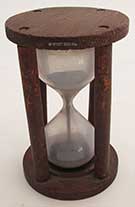
|
3.76 LOG TIMER. Scarce, highly sought after authentic mid-19th century ship's sand glass timer used in conjunction with a chip log to determine the ship's speed underway. This charming example is of 14 seconds duration and has round ends of turned oak with 4 painted pine support columns. Its simplicity shouts "American," since French and English examples from the era were more ornate and made of exotic woods. The glass is of one piece, hand-blown construction with a cloth plug in one end. It contains iron filings, the standard as used in the 1850's. It measures exactly 3 inches in diameter and 4 ¾ inches tall. Excellent original condition, fully functional and showing great age but no abuse. |
perspective |
top |
plate |
3.42 NAVIGATOR’s RULES. A very nice example of late 19th century rolling parallel rules made by the well-known English maker “J.A. Nicholl & Co.” as impressed in the top of the rule. This substantial, highly accurate navigational instrument is made of brass with a boxwood body. It consists of a heavy brass axel connected to knurled rollers on each end. These move freely allowing the rules to run over the face of a chart parallel to the course line. To assist the navigator in plotting, knurled brass knobs are provided on each end of the rules. This precision device is housed in its high quality mahogany box with machine dovetailing and interior felt supports. Two brass hook and eye closures insure the contents are secure. The rules measure 18 inches long by 2 ½ inches wide. Unlike trapezoidal parallel rulers, the extent of this ruler’s travel is endless. The box measures 19 inches long by 3 ¼ inches wide and 1 7/8 inches thick. Outstanding original condition in all respects. 249 |
bottom |
box |
maker |

|
3.38 RARE SURVEYING SEXTANT. Most important, very high quality marine navigational sextant which also served as an astronomical and hydrographic survey instrument. This magnificent all brass precision instrument is signed on the large arc “Cary, London 2842 Gold & Platina.” The large arc is calibrated in single degrees from -5 to 150 degrees divided by 10 arc minutes, effectively making it a quintant. The scale is beautifully engraved on solid gold overridden by a platinum vernier scale. The division of the vernier from 0 -10 allows for a reading to an accuracy of 10 arc seconds. Interestingly the sheet brass frame is very similar to the one invented by Edward Troughton in the 1780’s, in that it is secured to a second frame by screws for rigidity and accuracy. This amazing instrument has many unusual cutting edge features. The index arm stop and the fine adjust tangent screw are spring loaded, allowing a much smoother reading. To take the reading there is a small adjustable magnifier built into the index arm, as well as a small frosted glass window mounted just above the magnifier to provide maximum lighting for the reading. Above the magnifier, mounted to the index arm, is a bubble level which can be locked into place or allowed to swing free indicating the plane of the earth, also known as an artificial horizon. This sextant is equipped with its full set of 4 colored glass index filers and 3 horizon filters for viewing in different atmospheric conditions. Both the index and horizon mirrors are in place and functional. Attesting to Cary’s attention to minute detail, both are equipped with pin-adjusted screws which are covered by threaded knurled caps! This sextant has an adjustable height eyepiece operated by a knurled knob on the reverse. The eyepiece supports a long telescopic sighting tube which fits nicely into the holder with a bayonet twist. The back side of the sextant frame has 3 brass “feet” and a rosewood handle reinforced with brass. But there its commonality with other fine sextants is surpassed. It is mounted, through its handle to an exceptionally heavy and well-machined tripodal stand. The stand is signed “G. LEE & SON, THE HARD, PORTSMOUTH.” It is equipped with 3 knurled leveling screws on a folding base mounted with a support much like a library telescope. At the top is a revolving platform with a tangent locking screw and fine adjust stop. These are for precisely orientating the instrument to the heavens. The tilt of the sextant fore and aft is accomplished by 2 pivoting levers attached to the stand. Each is attached to a brass-encased lead counterweight. The action is flawless! The sextant itself measures 10 ¾ inches wide on the large arc and 10 ½ inches on the index arm. It stands 18 inches high and 10 ¼ inches wide on the base. Circa 1820. Absolutely outstanding condition. As rare as it gets. Museum quality. Price Request |
perspective |
detail |
back |
reverse |
sextant |
maker |
stand maker |
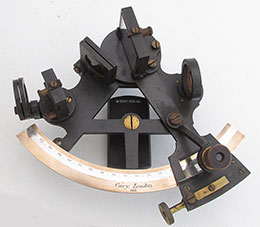
|
3.30 MINIATURE SEXTANT. Truly extraordinary, if not completely unique, 2nd quarter 1800’s midshipman’s sextant (aka lifeboat sextant) made by the highly revered early English maker William Cary as beautifully hand-engraved on the large silver arc “Cary, London 968.” This amazing instrument is actually a semi circumferentor having a scale divided to a full 180 degrees of arc, sub-divided to 20 arc minutes! This was a spectacular feat of precision engineering at the time, attesting to Cary’s genius. It was not attempted by any of his contemporaries even on larger more easily calibrated instruments. This pristine all brass instrument is in its original blackened finish. The tangent fine adjust knob works in consort with the knurled index arm stop. The large scale is overridden by the index arm vernier scale calibrated to provide a reading down to an accuracy of an amazing 20 arc seconds! This was virtually unheard of for an instrument of its size at the time. It is a cutting age accomplishment literally akin to the moon exploration more than 125 years later! The index arm is equipped with an adjustable magnifier to view the reading. This compact navigational instrument has both index and horizon mirrors and a height adjustable sight holder which accommodates 3 telescopes housed in its box. Incredibly, 2 index filters and 2 horizon filers are also provided. On the reverse it has a sculpted solid ebony handle and 3 positioning “feet.” This diminutive instrument measures a mere 5 ¼ inches wide on the broad arc and 4 ½ inches long on the index arm. It is housed in its original rich African mahogany box with very fine hand-dove tailed construction measuring 5 ½ inches square by 3 ¼ inches thick. It is complete with all three sighting tubes and 2 eye piece filters. Incredibly the box lock is complete with its original skeleton key! Within the lid are two original labels. The first is by “HENRY PORTER Successor to the Late W. CARY.” The second is a hand-inked label dated 1888 indicating the correction of the index error in June 1888. This extraordinary presentation is worthy of the finest world class museum. In fact it must ultimately go to a museum as the trail of its past dictates. We are all caretakers of our prized possessions, but not owners in perpetuity. 3900 |
box |
in box |
contents |
back |
label |
signature |

|
3.18 AZIMUTH INSTRUMENT. Genuine, highest quality ship’s navigational instrument made by the esteemed American makers, “NEGUS NEW YORK” as stamped on the bed plate and again on the maker’s tag on the box. This precision instrument is all brass with a blackened finish. It has an optical quality glass prism which rotates via two knurled brass knobs. Designed to be set atop the ship’s main steering compass in a binnacle, it has a magnifier set in a tube below the prism to enhance the current compass reading while at the same time providing an image of the sun or celestial body. Two pivoting sun shades are provided for looking at the former. A removable “line-of-sight” pole is provided, as is a bubble level for assuring totally accurate level readings. This instrument fits the top of a standard size 8 inch Navy magnetic compass. It measures 9 ¼ inches long by 3 3/8 inches wide and 8 ¾ inches high with the removable vertical post. Absolutely mint, untouched, original factory condition in its original dove-tailed wooden box with brass hardware measuring 10 1/4 by 7 ½ inches by 5 ½ inches thick. 199 |
box |
open |
instrument |
detail |
mirror & bubble |
maker |

|
3.03 EARLY AMERICAN NAUTICAL COMPASS. Really exceptional maritime compass of unusally small size produced by the short-lived American scientific and nautical instrument making firm of “FRYE & SHAW * NEW YORK*” as hand-engraved around the pivot of the compass card. This high quality functional ship’s compass has a paper over mica drycard compass rose marked in single points of the compass with the cardinal and sub-cardinal pointes identified. North is designated by a classic fleur-de-lis. The brass pivot is of conical form reminiscent of compasses dating back to the 17th century! Also in keeping with tradition, the East point is embellished with yet another fleur-de-lis. The card is housed in the weighted brass bowl slung in gimbals mounted in its heavy brass cylindrical housing complete with the original press-fit knurled brass lid. The compass is very lively, accurate, and gimbals properly. The presentation measures 3 5/8 inches in diameter and 2 inches thick with the lid. Condition is absolutely outstanding and original, in all respects. Totally original. This is a sweetheart of an offering, worthy of any museum. Not esspcially cheap, but offered here before inflation. Worth every penny. Try to find another! 888 |
closed |
with lid |
gimbaled |
card |

|
3.92 RARE HISTORIC MINIATURE SEXTANT. Truly extraordinary, mid-1800s presentation sextant made by one of England’s most elite makers! This delightful little instrument is signed on the large arc in perfect hand-engraved script, “Troughton & Simms, London.” Of all brass construction with a V-shaped frame, the sextant has an inlaid silver arc reading from -5 to 160 degrees, effectively making it a quintant. Incredibly, these divisions along with the vernier scale on the index arm, allow this sextant to match the accuracy of it larger cousins, down to 20 arc seconds! A pivoting magnifier is provided for taking the reading. The index arm has a miniaturized version of a thumb screw stop and tangential fine adjust. The sextant is complete with its 2 horizon filters and 2 index filters in perfect condition. The index mirror and horizon mirror are in beautiful condition. The whole presentation is totally complete in its shaped rich mahogany box. The octagonal ebony handle screws into the frame with a secure fit. There are two optics, a peep and a telescope which fit into the height-adjustable sight holder. Rounding out the accessories, there are both sight tube filters, mirror adjustment tool, and the functional skeleton key for the brass lock. Of monumental importance for its value and appeal is the beautifully-hand-engraved presentation on sterling silver inlaid into the top of the box. It reads, “Presented at the Public Examination on the 13th of June 1851 to Gentleman Cadet, Henry Goodwyn by the Honble Court of Directors of the East India Company, as a mark of the Courts approbation of his attainments in Mathematics while at the Military Seminary.” The overall presentation is nothing short of phenomenal for an instrument 166 years old! Totally complete and virtually in the same condition when it was made. All surfaces are in their original bright brass lacquer finish. This is a nautical gem of the highest order, if ever there was one! Most certainly worthy of the finest world class collection and/or museum. SOLD |
perspective |
in box |
contents |
in back |
sextant |
vernier |
presentation |
makers |

